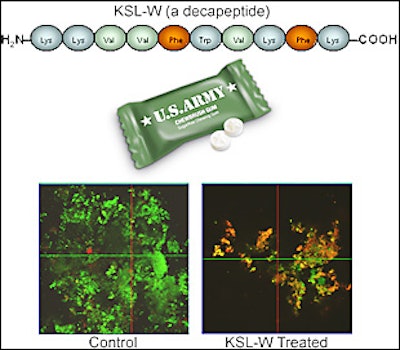
The U.S. military has created a chewing gum designed to help reduce the dental issues plaguing its troops.
"Combat gum" has an ingredient that targets caries-causing bacteria, according to an article in the Daily News, and it could potentially reach the general public. The gum was created by the U.S. Army Institute of Surgical Research in San Antonio. During seven years of development, the researchers incorporated the KSL-W peptide, which kills bacteria and prevents biofilm formation, according to the U.S. Army. It is now in clinical trials. If successful, 20 minutes of chewing after a meal could effectively prevent decay and gum disease.
 Antiplaque chewing gum to control dental plaque growth with KSL-W peptide as the active ingredient. Confocal images of 24-hour peptide- or water-treated (control) oral biofilms as revealed by live/dead staining: green = live, red/orange = dead. Image courtesy of the U.S. Army Insitute of Surgical Research.
Antiplaque chewing gum to control dental plaque growth with KSL-W peptide as the active ingredient. Confocal images of 24-hour peptide- or water-treated (control) oral biofilms as revealed by live/dead staining: green = live, red/orange = dead. Image courtesy of the U.S. Army Insitute of Surgical Research.Some 40% of Army recruits have three or more caries when they begin their service, noted Col. Robert Hale, commander of the U.S. Army Dental and Trauma Research Detachment. They must be treated before deployment, which impedes upon their time in basic training. Tooth pain that occurs after deployment results in the soldier being pulled from their post to be treated wherever there is a dentist.
Hale suggested that the gum would be available with a prescription within three to five years and to the general public in seven to 10 years, according to the article.















